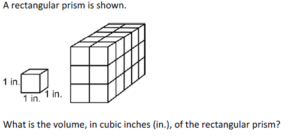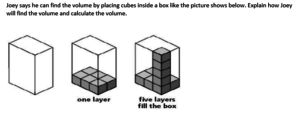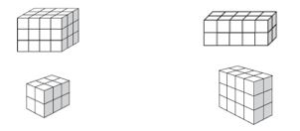MAFS.5.MD.3.3: Recognize volume as an attribute of solid figures and understandconcepts of volume measurement.
a. A cube with side length 1 unit, called a “unit cube,” is said to have “one cubic unit” of volume, and can be used to measure volume.
b. A solid figure which can be packed without gaps or overlaps using n unit cubes is said to have a volume of n cubic units.
MAFS.5.MD.3.4: Measure volumes by counting unit cubes, using cubic cm, cubic in, cubic ft, and improvised units.
[divider] [/divider]
Students are able to…
- Recognize volume as an attribute of three-dimensional space.
- Know when finding the volume is appropriate given the situation.
- Understand that the volume of an object can be measured by finding the total number of same-sized units required to fill the space without any gaps or overlaps.
- Find the volume of a rectangular prism by packing it full with same-sized cubes (such as centimeter cubes) and by counting the cubes.
Students are able to…because teachers:
- Plan activities where students find the volume of several rectangular prisms by counting cubes.
- Discuss scenarios that require finding area, perimeter, or volume and facilitate discussion in which students defend their decision to use the appropriate measurement.
- Plan questions to prompt students to consider how to find the volume if they have only enough cubes to cover the bottom of the rectangular prism but not enough cubes to fill the entire prism.
[divider] [/divider]
Questions to ask students:
- How can you use cubes to find the volume?
- Sample answer that indicates understanding: Take cubes of the same size like centimeter cubes and fill the rectangular prism without having any gaps. Count all of the cubes that it took to fill up the prism.
- Sample answer that indicates an incomplete understanding or a misconception: Take cubes and fill the prism to the top.
- How could you find the volume with cubes if you only have enough cubes to cover the bottom of the box?
- Sample answer that indicates understanding: Use the cubes to fill the bottom layer of the prism without any gaps or overlapping cubes. Count all of the cubes used in that bottom layer. Take some of the cubes you used on the bottom to stack them up on one of cubes to get to the top and count how many layers of cubes you would need to fill the prism to the top.
 Sample answer that indicates an incomplete understanding or a misconception: You can’t really solve this problem because you don’t have enough cubes but you could use the cubes to fill the bottom of the box and count them and then estimate how many more cubes would be needed to fill the box.
Sample answer that indicates an incomplete understanding or a misconception: You can’t really solve this problem because you don’t have enough cubes but you could use the cubes to fill the bottom of the box and count them and then estimate how many more cubes would be needed to fill the box.
[divider] [/divider]
FSA Notes
Cognitive Complexity Level: Level 1: Basic Recall
Achievement Level Descriptors:
Level 2: identifies scenarios where cubic units can be used to calculate volume
Level 3: counts unit cubes to find the volume of rectangular prisms; represents the volume of a solid figure as n cubic units
Level 4: uses unit cubes to create a rectangular prism with a given volume
Level 5: uses unit cubes to create two different rectangular prisms with one given volume
Assessment Limits:
Items may contain right rectangular prisms with whole‐number side lengths.
Figures may only be shown with unit cubes.
Labels may include cubic units (i.e. cubic centimeters, cubic feet, etc.) or exponential units (i.e., cm cubed, ft cubed, etc.).
Items requiring measurement of volume by counting unit cubes must provide a key of the cubic unit.
[divider] [/divider]
Additional Resources:
Additional in depth content knowledge:
Videos:
Learnzillion: Find Volume by Counting Cubes
Khan Academy: Measuring Volume with Unit Cubes
[divider] [/divider]
Sample Formative Assessment Tasks:
[divider] [/divider]
[divider] [/divider]
[divider] [/divider] Resources/Tasks to Support Your Child at Home:
Working for Wonka – Interactive Student Tutorial
Find the volume of the following rectangular prisms:



